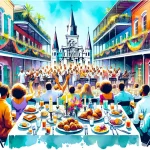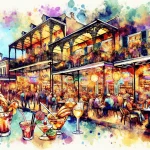In the culturally rich city of New Orleans, where music and traditions intertwine, Second Line Parades have become a cherished celebration that showcases the spirit of the community. These lively processions, led by brass bands and followed by joyous crowds, have deep-rooted origins dating back to the 19th century and continue to captivate locals and visitors alike.
In This Article
TL;DR
- Second Line Parades combine brass band music, dancing, and community festivities in a unique New Orleans tradition.
- These parades have historical ties to African and Creole cultural influences, evolving into a staple of New Orleans culture.
- Key features include brass bands, the “main line” (organizers and honorees), the “second line” (participants), and distinctive attire like parasols and handkerchiefs.
Historical Context of Second Line Parades
The origins of Second Line Parades can be traced back to the African and Creole cultural influences that shaped New Orleans. In the late 19th century, African American benevolent societies and social aid and pleasure clubs began organizing parades to honor their members and provide a sense of community. These early processions often included brass bands and were accompanied by dancing and celebration.
Over the years, the parade format has evolved, incorporating elements from jazz funerals and Mardi Gras traditions. The term “second line” itself refers to the crowd of participants who follow behind the “main line” of parade organizers, brass band, and honorees.
Cultural Significance and Community Impact
Second Line Parades play a vital role in community bonding and cultural expression in New Orleans. These events bring together people from all walks of life to celebrate shared joys, mourn losses, and showcase the resilience of the community. The parades have had a significant influence on local music, particularly jazz and brass band traditions, and have contributed to the preservation of New Orleans’ unique cultural heritage.
The parades also serve as a form of community support, with social aid and pleasure clubs often using the events to raise funds for various initiatives and to provide assistance to members in need.
Anatomy of a Second Line Parade
A typical Second Line Parade consists of several key components:
Brass Bands
The musical heartbeat of the parade, brass bands play a mix of traditional jazz, funk, and popular tunes to keep the crowd dancing.
“Main Line”
The main line includes the parade organizers, honorees (such as a wedding party or community leaders), and the brass band.
“Second Line”
The second line refers to the crowd of participants who follow behind the main line, dancing and celebrating.
Parade participants often wear distinctive attire, such as brightly colored suits and dresses, and carry accessories like parasols and handkerchiefs to add to the festive atmosphere.
Second Line Parades typically follow predetermined routes through New Orleans neighborhoods, often starting and ending at significant community locations like churches or social clubs.
Planning Your Visit to a Second Line Parade
The best time to experience a Second Line Parade is during the peak parade season, which runs from September through May. Some of the most popular parades take place during festivals like Jazz Fest and French Quarter Fest.
When attending a Second Line Parade, visitors should keep a few tips in mind:
- Be respectful of the community and the parade’s purpose, whether it’s a celebration or a more somber occasion like a jazz funeral.
- Dress comfortably for the weather and wear shoes suitable for dancing and walking.
- Bring water to stay hydrated, as parades can last for several hours.
- If you plan to join the second line, follow the lead of local participants and be mindful of the parade’s flow.
Safety and comfort are important considerations during a parade. Be aware of your surroundings, stay with the crowd, and pace yourself to avoid overheating or dehydration.
Musical Heartbeat: Brass Bands and Dance
Brass bands are the driving force behind Second Line Parades, providing the infectious rhythms that keep participants dancing. Some of the most prominent brass bands in the New Orleans Second Line scene include the Rebirth Brass Band, the Hot 8 Brass Band, and the Treme Brass Band.
These bands play a diverse repertoire, ranging from traditional jazz standards to contemporary pop and hip-hop tunes, all infused with the distinctive New Orleans sound. The interaction between musicians and the crowd is a key element of the Second Line experience, with participants often singing along, clapping, and dancing in response to the music.
Economic and Social Contributions
Second Line Parades have a significant impact on the local economy, particularly during major parade days. The events draw visitors to New Orleans neighborhoods, supporting local businesses like restaurants, bars, and shops.
The parades also contribute to the city’s tourism industry, with many visitors eager to experience this unique aspect of New Orleans culture. Social aid and pleasure clubs often use parade-related events to raise funds for community support initiatives, such as providing scholarships, assisting with funeral expenses, or contributing to local charities.
Preserving Tradition and Innovating for the Future
Efforts to preserve Second Line traditions are ongoing in New Orleans, with community organizations and cultural institutions working to pass down knowledge and skills to younger generations. Many social aid and pleasure clubs offer mentorship programs and workshops to teach the art of parading, costume design, and brass band music.
At the same time, new trends and innovations continue to shape the Second Line scene. Some parade organizers have incorporated contemporary music and dance styles, while others have experimented with new routes and themes. Technology and social media have also played a role in spreading parade culture, with many events now live-streamed or shared through online platforms.
Expert Insights and Further Reading
To gain a deeper understanding of Second Line Parades, consider exploring the following resources:
- The Backstreet Cultural Museum (1116 Henriette Delille St, New Orleans, LA 70116) offers exhibits and tours focused on Second Line culture and Mardi Gras Indians. Open Tuesday-Saturday, 10am-4pm. Admission: $10 for adults, $5 for students and seniors.
- “The ‘Treme’ Sidewalk Steppers: Parade and Social Aid and Pleasure Club” by Matt Sakakeeny, a book that explores the history and cultural significance of Second Line Parades.
- “By the Hand of the Unseen: The Influence of Social Aid and Pleasure Clubs on New Orleans Music and Culture” by Bruce Raeburn, an article exploring the role of social aid and pleasure clubs in shaping the city’s cultural landscape.
- WWOZ 90.7 FM (https://www.wwoz.org/), a local radio station that provides updates on Second Line Parade schedules and live broadcasts of events.
By immersing yourself in the rich history and vibrant present of Second Line Parades, you’ll gain a deeper appreciation for this quintessential New Orleans tradition and the community that keeps it thriving.






